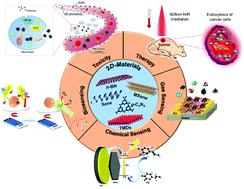当前位置:
X-MOL 学术
›
Chem. Soc. Rev.
›
论文详情
Our official English website, www.x-mol.net, welcomes your
feedback! (Note: you will need to create a separate account there.)
Two-dimensional materials in biomedical, biosensing and sensing applications
Chemical Society Reviews ( IF 40.4 ) Pub Date : 2020-11-18 , DOI: 10.1039/d0cs00150c Nasuha Rohaizad 1, 2, 3, 4, 5 , Carmen C. Mayorga-Martinez 6, 7, 8, 9, 10 , Michaela Fojtů 6, 7, 8, 9, 10 , Naziah M. Latiff 3, 4, 5, 11 , Martin Pumera 6, 7, 8, 9, 10
Chemical Society Reviews ( IF 40.4 ) Pub Date : 2020-11-18 , DOI: 10.1039/d0cs00150c Nasuha Rohaizad 1, 2, 3, 4, 5 , Carmen C. Mayorga-Martinez 6, 7, 8, 9, 10 , Michaela Fojtů 6, 7, 8, 9, 10 , Naziah M. Latiff 3, 4, 5, 11 , Martin Pumera 6, 7, 8, 9, 10
Affiliation

|
Two-dimensional (2D) materials are at the forefront of materials research. Here we overview their applications beyond graphene, such as transition metal dichalcogenides, monoelemental Xenes (including phosphorene and bismuthene), carbon nitrides, boron nitrides along with transition metal carbides and nitrides (MXenes). We discuss their usage in various biomedical and environmental monitoring applications, from biosensors to therapeutic treatment agents, their toxicity and their utility in chemical sensing. We highlight how a specific chemical, physical and optical property of 2D materials can influence the performance of bio/sensing, improve drug delivery and photo/thermal therapy as well as affect their toxicity. Such properties are determined by crystal phases electrical conductivity, degree of exfoliation, surface functionalization, strong photoluminescence, strong optical absorption in the near-infrared range and high photothermal conversion efficiency. This review conveys the great future of all the families of 2D materials, especially with the expanding 2D materials’ landscape as new materials emerge such as germanene and silicene.
中文翻译:

生物医学,生物传感和传感应用中的二维材料
二维(2D)材料处于材料研究的最前沿。在这里,我们概述了它们在石墨烯以外的应用,例如过渡金属二卤化碳,单元素Xenes(包括磷和铋),碳氮化物,氮化硼以及过渡金属碳化物和氮化物(MXenes)。我们讨论了它们在从生物传感器到治疗剂的各种生物医学和环境监测应用中的用途,它们的毒性及其在化学传感中的用途。我们重点介绍2D材料的特定化学,物理和光学特性如何影响生物/传感性能,改善药物输送和光/热疗法以及影响其毒性。此类属性取决于晶相的电导率,剥落程度,表面功能化,强的光致发光,在近红外范围内的强光吸收和高的光热转换效率。这篇评论传达了所有2D材料家族的美好未来,尤其是随着新材料(例如锗烯和硅烯)的出现,随着2D材料领域的不断扩大。
更新日期:2020-12-09
中文翻译:

生物医学,生物传感和传感应用中的二维材料
二维(2D)材料处于材料研究的最前沿。在这里,我们概述了它们在石墨烯以外的应用,例如过渡金属二卤化碳,单元素Xenes(包括磷和铋),碳氮化物,氮化硼以及过渡金属碳化物和氮化物(MXenes)。我们讨论了它们在从生物传感器到治疗剂的各种生物医学和环境监测应用中的用途,它们的毒性及其在化学传感中的用途。我们重点介绍2D材料的特定化学,物理和光学特性如何影响生物/传感性能,改善药物输送和光/热疗法以及影响其毒性。此类属性取决于晶相的电导率,剥落程度,表面功能化,强的光致发光,在近红外范围内的强光吸收和高的光热转换效率。这篇评论传达了所有2D材料家族的美好未来,尤其是随着新材料(例如锗烯和硅烯)的出现,随着2D材料领域的不断扩大。











































 京公网安备 11010802027423号
京公网安备 11010802027423号